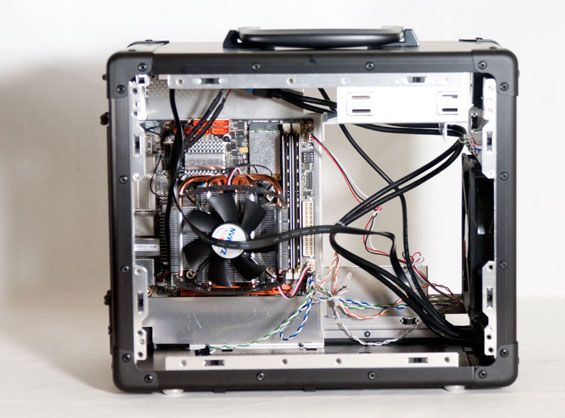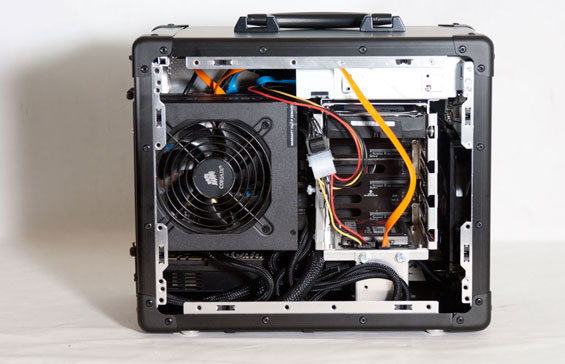Lian Li PC-TU200: On the Road With Lian Li
by Dustin Sklavos on October 31, 2011 12:45 AM EST- Posted in
- Cases/Cooling/PSUs
- Mini ITX
- Lian Li
Assembling the Lian Li PC-TU200
On the ease of assembly continuum for cases, at one far end you have Corsair (really the brand in general): couldn't be any easier to put together short of including a technician to just do it for you. On the opposite end you'll have some of SilverStone's more exotic cases (such as the Raven RV03), but I have to say the benchmark has really been set: thus far, out of every case I've assembled, the Lian Li PC-TU200 has been among the hardest if not the hardest case to put together.
I don't expect a case this small to be a tool-less design, far from it. But while many of SilverStone's exotic designs feel like puzzles with elegant solutions reflected in the documentation they ship with, the TU200 oftentimes feels like a bit of a head scratcher, not at all dissimilar to the V353 we reviewed recently. Advance warning: newbies need not apply here, and if you're going to build in the TU200 it may behoove you to have it in mind before you even order the first component.
This is the first time I've ever consulted the instruction manual to figure out how to get the side panels off: remove the two thumbscrews in the back (at the top), and then press the levers and the panels pop out. It's kind of cool but not something you'd immediately expect. To Lian Li's credit, all of the mechanisms involved feel very secure and built to last.

Their instruction manual will tell you to insert the I/O shield for the motherboard and then just pop the board in, but I found that there simply isn't enough clearance to get the motherboard in (at least not remotely easily) without completely removing the drive cage, a task that theoretically shouldn't be required if the included instructions are to be believed. That said, I'm always happy when the standoffs for the motherboard are already built into the tray, so once you can shimmy the board in and squeeze it up against the I/O shield, it's just a matter of getting the four screws in place.
After that, though, you get to what I'm convinced is the TU200's fatal flaw: the drive cage. I honestly feel like the way drives are mounted in the TU200 is just plain over-engineered. Here's how drives are supposed to mount, at least in theory: for 3.5" drives, you'll loosen the thumbscrew on the left side of the cage, in the extruded lip of the cage, then slide it up, opening the "rails" for inserting the drive. Then put four screws with large, wheel-shaped heads into the side mounts of the drive, slide the drive into the "rails" and into the SATA and power ports in the backplane, then basically close off the rails with the thumbscrew. I wish there were a clearer way to explain it than that.
2.5" drives are simultaneously better and worse: mount four screws into the bottom of the drive with rubber grommets around them (broad grommet side against the drive itself), then insert it into the open holes at the bottom of the cage (or case) and push it back into place. In the cage, this will block off the bottom bay, while in the case itself it runs the risk of butting up against the video card. Either way, you're going to have to route cables around the top of the cage instead of from the back.
Finally, to mount a 5.25" drive, you need to unscrew two screws on each side of the enclosure's interior that hold the bay cover in place, slide the drive in from the front, screw the bay cover back on, and then screw in the drive. Phew.

This is all over-engineered, but the real problems have to do with the drive cage itself. While I was able to get things mounted without too much trouble, the cage actually blocks a tremendous amount of air from the front fan. Worse still, the extrusion on the left side of the cage, where the thumbscrew that locks the drives into place is, drastically limits the size of power supply you can fit into the case. Lian Li's spec page originally listed the case as being able to support a power supply 180mm in length, the length of our usual test PSU. That PSU just plain didn't fit; cables mushing up against the lip of the cage (along with the power supply itself) saw to that. I had to use a 160mm power supply from Corsair, the AX850, and even then the modular cable plugs drastically interfere with clearance. I also had to flip the power supply since most PSUs have the plugs closer to the side with the intake fan: that meant the intake was left with a small gap between it...and the side panel. No es bueno. There's a reason their spec page now lists the power supply clearance at 140mm, and you'll want to adhere to that requirement.
Finally, because of the monster cage, routing cables turns into a massive chore, and jimmying a video card into the enclosure (particularly our GeForce GTX 580) winds up being an exercise in brute force. This is, I think, the first enclosure I've seen where a modular power supply might actually be a bad idea. Not only that, but I feel like cramming an ATX power supply into a case design like this is just...unwise. I know Lian Li was going for an enclosure that can handle a top-of-the-line graphics card, but there are smaller power supply form factors that may have been more ideal for something like this. Deepening the enclosure an inch or two, moving to a smaller power supply form factor, and mounting it up behind the optical drive might have improved things. That, and a case with an airflow design like this one would benefit tremendously from even a tiny tower-style cooler on the CPU.














53 Comments
View All Comments
apparition47 - Tuesday, November 1, 2011 - link
I built a mini-ITX rig for the gf using this case about 1-2 months ago. It was my first non-ATX build, so it was an interesting project. I managed to wedge a GTX 560 Ti in there with a i5 2400. I'm still dumbfounded how you can get so much power into a case like that, having built all my gaming rigs on ATX up til now.Hopefully when it's time for my next PC, another mini-ITX case will be suitable.
n13L5 - Friday, September 7, 2012 - link
Check the PC-Q18 case. same size, no optical drive bay, no external bay at all, actually.I was looking at it, but I need a BD drive cause I do watch movies sometimes.
ac2 - Monday, October 31, 2011 - link
Dustin (and Jared), first just want to thank you for all the stuff you put out here. I really don't give a **** about all the smartphone/ tablet reviews so particularly look forward to your work on systems/ mobos/ cases/ PSU. If you could do a roundup of the most popular LCD monitor size that would be great.Re UEFI, there is a lot of discussion re the secure boot option being mandated by MS for Windows 8 and how this may be interpreted by OEMs to lock out other OSs from Win 8 pre-installs. This may be a storm in a teacup, but could you please keep a eye out for this on future mobo/ system/ laptop reviews, particularly calling out such systems that do not allow the user to install other OSs as a result of this.
anikolayev - Monday, October 31, 2011 - link
Seconding IkethWHY, WHY do I need an optical drive on the road? WHY?
When are these manufacturers going to figure it out that there's a market for mATX cases that have room ONLY for an SSD.
Even on my main rackmount PC I tossed out the optical drives just last week.
WHO NEEDS A DVD BURNER WHEN YOU CAN HAVE A SECOND OR FULL SIZE GPU? Seriously people, seriously.
Dustin Sklavos - Monday, October 31, 2011 - link
While digital distribution is more and more becoming a way to go, every so often there are still games that will need disc authentication to load. It's stupid and I have VERY few now, but nonetheless it's a consideration.7Enigma - Monday, October 31, 2011 - link
That's what a USB external optical drive is for. I personally only use mid-tower desktop systems but if I was more mobile-oriented I would love a smaller box similar to this.It is crazy that no one seems to understand what enthusiasts want in a particular case. We seriously need to start an Anandtech hardware company. "Hardware by enthusiasts for enthusiasts" or something like that.
Ditch the drive cage, ditch the optical drive, increase the space behind the mobo by 1" to allow for the 2.5" SSD/HDD and cable routing. You'd have a clean wiring on the component side, and enough space on the backside for wiring and drives.
This is so obvious I'm surprised Apple hasn't tried to patent it yet (yup I went there).
Who's going to be the obvious genius to build this simple design?
Taft12 - Monday, October 31, 2011 - link
A consideration that should be met with external DVD drives onlyhttp://www.newegg.ca/Product/Product.aspx?Item=N82...
BansheeX - Monday, October 31, 2011 - link
Why does these dinosaur drive sizes persist? Slimline and 2.5 need to become standard already, good god.Dustin Sklavos - Monday, October 31, 2011 - link
5.25"...the slimline form factor makes it a bit harder to fit certain types of drives into, which drives up cost.3.5"...we may be up to 1TB in 2.5" mechanical hard drives right now, but we're up to 4TB in 3.5" mechanical hard drives, so that pretty much speaks for itself.
saurey - Monday, October 31, 2011 - link
I'd remove the cage altogether, then get a 1x5.25 to 4x2.5" drive bay - only takes 1 power connector to run 4 drives and have that be my storage solution.I'd also put some rubber feet stick ons underneath the existing case feet to raise it a about a cm higher for better intake for GPU.
Also would play with the idea of mounting the PSU upside down to help pull air out of the case.
I wonder how high the maximum cooler on the CPU is? I really like the corsair hydro coolers but there doesn't seem to be a way to fit that... Maybe where that dumb drive bay is?
Agreed no need for 3.5" drives, especially in this case and 5.25 bay is just a bonus so I can use my 4x2.5" rack in it.